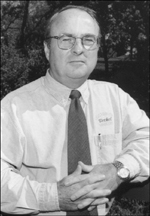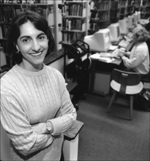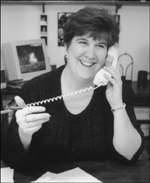When students in Bethel Theological Seminary’s In Ministry program meet for the first time, their nametags don’t bear names. They bear e-mail addresses. That’s because the students have already spent the better part of a month interacting on line, but haven’t yet put faces or names together with the personalities they’ve encountered on their computers.
 |
| Gregory Bourgond heads up Bethel’s In Ministry Program.
Photographs by Dawn Villella
|
The students are part of a unique master of divinity program at Bethel, a Baptist General Conference school that has campuses in St. Paul, Minnesota, and San Diego, California. They can complete their degree in five years, with only four weeks per year away from home (two in February, two in August). The degree is accredited by the Association of Theological Schools, and thus fits that group’s requirement that no more than one-third of the degree be completed via distance education, but innovative use of technology has allowed for “on-site” courses with lots of off-campus input.
Here’s the recipe. Students take four one-week courses per year on campus (in two two-week chunks), but they begin to do assignments for those courses up to a month in advance as they interact with faculty and other students by e-mail, conference calls, video-streamed lectures, and PowerPoint presentations. Then they come together—with their unique nametags—and learn face-to-face during back-to-back weeks of eight-hours-per-day classes, one week per course. Finally, they go home to more reflective work and interaction. Students also can take an additional two courses per year entirely off site. It’s not a lock-step process; students can take electives of their own choosing. They also have some choices about the sequence of required courses and can do on-site work at either the Minnesota or California campus or both
“They do compare notes on who is taking what when,” said Gregory Bourgond, director of the program, “and you can guess which campus is more popular in February.” About 150 students from thirty-seven states are enrolled in the program, which is five years old and will graduate its first crop of students this spring.
Upgrading As a Way of Life
Bourgond has been with the project from the beginning, and he is candid about the speed with which the technology is changing. “I will never be satisfied with this program,” he announced as he bounced along the St. Paul campus’s brick and glass hallways carrying his laptop and projection equipment for a demonstration of the latest methods of teaching at a distance. “Come another week and it may have changed.” Keeping track of change comes naturally to Bourgond, who studied at Bethel’s San Diego campus after a career in naval intelligence, then pastored a San Diego church before becoming dean of academic affairs and instructional technology.
Neither is Bourgond shy about the unique costs and pressures of the program. “Students can get upset with change,” he explained, “and they need support, so you need to plan for at least a fifty to seventy percent increase in administrative support for this kind of program. You also have to be aware of the shelf life of the technology you purchase. Don’t go into this kind of program expecting to make money in the first year or two. On the other hand now, it’s all new money. These are students who wouldn’t be doing a degree anywhere else, because they can’t pick up and move.”
Accessing New Technologies
The technology ranges from whiz-bang to mundane but is carefully thought out. “We’re getting pretty proficient at sixteen-person conference calls,” Bourgond said. Such calls sometimes begin a course or serve as a forum for major announcements which might need immediate clarification. Presentation of course materials is geared to the whole range of student learning styles: students might be able to see a lecture live via video-streaming (on-line video) or listen to it while viewing a PowerPoint outline, which simulates a traditional slide presentation. They can now do oral in-class presentations via e-mail. They respond to reading and lectures—and to each other’s responses—by e-mail on course websites. And they have people they can call for technical support when they can’t figure out how to do it.
“Sometimes it’s simple—a student will download a program and forget to install it,” according to Ellen Hallman, the program’s administrative assistant. “Other times it gets more complicated, but students are okay knowing there’s someone to talk them through it.” Hallman does a fair amount of talking students through non-technical as well: she’s the person they contact for general information, the one who sends them e-mail reminders of schedules and updates the on-line newsletter, and the one who tracks them down if they start to slip off the screen.
 |
| Adjunct professor Jeannine Brown, put off at first by computers, now delights in saying, “How can this work? I’ve got an idea.” |
Faculty also need some hand-holding as they enter the technological wonderland. All faculty are required to teach in the In Ministry program, and most have said, “Yeah, sure, why not?” according to Mark McCloskey, dean of transformational leadership. He described Bethel’s faculty as “pretty young and flexible at heart.” Even one member who is retiring next year has taken on technology-assisted teaching.
Jeannine Brown, a new and young adjunct professor of biblical studies, concurs, “This isn’t a natural area for me. Word processing is about all I’d done on a computer. But I loved the idea of saying, ‘How can this work? I’ve got an idea.’ and having help to make it happen. I couldn’t have guessed ten years ago that I’d be doing this kind of teaching, but I like it.” All faculty are also required to train in the school’s computer lab so that they have basic web course authoring skills.
 |
| Program manager Kristen Anderson has become an expert in dreaming up technological maneuvers to enhance teaching. |
Kristen Anderson is program manager for In Ministry, and she does some of the conceptualizing of new ways to get information delivered. For an evangelism class in which on-site students were assigned a five-minute telling of their faith stories, she arranged streamed audio recording on line for the distance version of the course. Preaching students videotape their sermons. Student reports can be posted on line and then followed up with a conference call for feedback. “It’s a matter of discerning the teacher’s style and working with it,” she said. Faculty are protected as well as challenged by the guidelines of the program. It is expected, for example, that student e-mails will be answered within twenty-four hours. “It would be overwhelming with less turn-around time,” conceded Bourgond.
The Students’ Context
There are two factors which make this program unique. One, of course, is the off-site technologically enhanced instruction. The other—less eye-catching, but absolutely essential—is the fact that the students are “in ministry.” Their numbers include not only pastors and youth workers, but also a juvenile probation officer and a professional firefighter. Their lives give them “a problem-solving orientation toward learning,” according to Mark McCloskey, who taught his first In Ministry course this fall.
“I feel like I’m preaching to the choir sometimes,” said Jeanine Brown, “I’ll be trying to make a point that my residential students have struggled with, and the comment will come back, ‘Hey, I live this!’”
Ellen Hallman has her own take on what makes the students unique: “They’re used to thinking about other people. In the midst of an on-campus session, when I was very, very busy, I felt a tap-tap on my shoulder, and a student asked, ‘Did you get to eat lunch today?’ I wouldn’t expect that of our residential students.” Could the program work with younger students without a grounding in their local churches? Nobody seems willing to just say no, but faculty frown as they try to figure out how that might work.
No Other Way?
The leitmotif that runs all around the program is, “These students couldn’t have gotten a seminary degree without this program.” Family obligations are often cited: one student is a mother of six (although only one remains at home). Other students are rooted in jobs, deeply attached to the ministries in which they serve. Admissions officer Jack Hallman said, “God doesn’t call someone to a ministry and then yank them out of it.”
It is clear that everyone who makes the point really believes it, and it is made often, but something about the cumulative effect is not entirely persuasive. A statement from Bob Samsel, associate pastor of Grace Baptist Church in Bristol, Connecticut, with one more year to go in the In Ministry program makes it clear. He said, “About six years ago we were planning to move the family out to Minnesota so that I could attend Bethel Seminary full-time, but God had a different plan. This program has made it possible for my family to enjoy some stability while I was able to answer the call of God to full-time ministry. I praise the Lord that he made this all possible.”
In other words, it would have been extremely difficult in some cases for these students to have done a residential degree program. They might have had to wait or disrupt their children’s schooling, but they could have, and might have, had the In Ministry option not existed. A time apart from the comfortable familiarity of home has long been a part of the process of preparation for ministry at least since Jesus went off into the wilderness. In many cases this time apart has been considered a necessary part of the formation of church leaders, not just a practical necessity. And Bethel hasn’t eliminated this piece of theological education, just altered it by compressing into bite-sized, two-week chunks the time spent in face-to-face community. To quote Samsel again, “I would say that if it were not for the on-campus experience, this program would not have what I need in a seminary education. Relationships are a core value, and the intensives give me that opportunity.”
Not every student would agree with Samsel. Fully forty-one percent of the In Ministry students interviewed by Donald L. Tucker, who wrote his doctoral dissertation at the University of Pennsylvania on the In Ministry program, said that they would remain in the program if it were done entirely via distance learning.
Bethel hasn’t uttered the last word on where formation takes place. They have, however, recast the question.
 |
| Ellen Hallman, the program’s administrative assistant, provides technical and not-so technical assistance to the In Ministry students. |
That question has to do with the nature of community, of whether it is possible to be in community with people you don’t meet physically on a regular basis. Those involved with In Ministry are unanimous in their insistence that there is a real and unique sense of community present. Ellen Hallman compares it to the sort of relationship developed by people who meet regularly for retreat: she tells stories of students who were sustained through illness and other personal crises by the prayers of their fellows around the country, and of the teary reunions on campus later. Others point out the value of multiple communities—the ones in which the students work and the ones online. Certainly students who live within reasonable driving distance of one another have kept up face-to-face friendships begun in class. Again, the question: What kind of communities are necessary for the formation of church leaders?
Bethel has raised the bar for distance theological education—and in several ways. Your school now needs to make a more convincing case to attract residential students than you did before there was a quality M.Div. available via distance. (Bethel is expanding its on-line program offerings. The school is launching a master of arts in children’s and family ministries, and it has contracted with Willow Creek, a megachurch in South Barrington, Illinois, to offer an M.A. in transformational leadership geared to that community’s specific needs.) And should you start a similar program, you will need to pay close attention to just how user-friendly you can make it. Bethel has created its niche in the growing field of technologically assisted education delivery. Does your school have its own niche to carve out here?
Questions for the board:
-
If you plan to offer instruction off site, how much time together do you think students need in order to form community? How much student community—and what kind—do you think is necessary?
-
Where can you find “new money” for the technology you need?
-
What kind of quality control do you need to cope with the technology you’re using?
-
What kind of tech support do you provide students and faculty?